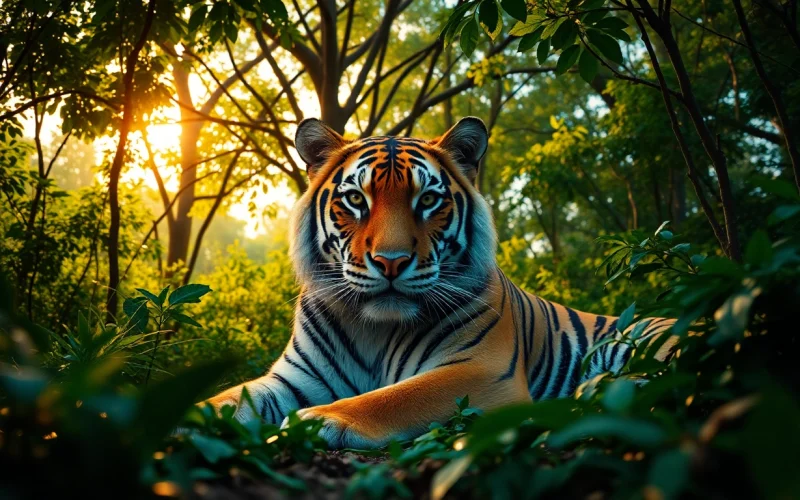Introduction to Tiger Safaris
The allure of the majestic tiger in its natural habitat is a powerful draw for wildlife enthusiasts across the globe. Among the most sought-after experiences is embarking on top best tiger safari tours, especially in India, where the vast grasslands and thick forests offer a sanctuary for these incredible big cats. Tiger safaris not only provide the thrill of spotting these magnificent creatures but also immerse visitors in the rich ecosystems that support a plethora of wildlife. This comprehensive guide explores what a tiger safari entails, the historical significance of tiger conservation in India, the top parks to visit, and practical tips for planning an unforgettable experience.
What is a Tiger Safari?
A tiger safari is an organized expedition aimed at observing and photographing tigers and other wildlife in their natural habitats. These safaris typically take place in national parks and wildlife reserves where tigers are known to roam freely. Most tours are conducted in specially designed safari vehicles, allowing guests to traverse the rugged terrains of the parks while ensuring safety and comfort.
History and Conservation of Tigers in India
India is home to approximately 70% of the world’s tiger population, making it a global hotspot for tiger conservation. Tigers were once abundant across the Indian subcontinent, but as human activities encroached into their habitats, their populations dwindled sharply. The late 20th century, in particular, saw significant declines due to poaching and habitat loss. However, initiatives like Project Tiger, launched in 1973, have made considerable impacts. This project aimed to create tiger reserves and provides ongoing funding for habitat protection, which has led to a gradual increase in tiger numbers.
Why Go on a Tiger Safari?
Going on a tiger safari is an experience of a lifetime. Here are several compelling reasons to consider this adventure:
- Wildlife Observation: Witnessing tigers in their natural setting is an awe-inspiring experience that connects visitors with nature and wildlife conservation.
- Educational Opportunities: Safaris often include guides who provide insights into tiger behavior, their ecosystems, and ongoing conservation efforts.
- Adventure and Exploration: The thrill of exploring diverse landscapes and the unpredictability of wildlife sighting creates an exhilarating atmosphere.
- Photography Opportunities: Capture stunning images of the iconic tiger and other wildlife in breathtaking locations.
Top National Parks for Tiger Safaris
Bandhavgarh National Park
Located in Madhya Pradesh, Bandhavgarh National Park is renowned for its significant tiger population and breathtaking scenery. The park boasts dense forests, rolling hills, and ancient ruins that add to its mystical charm. Bandhavgarh was once a royal hunting ground, and today it is a premier destination for spotting tigers. Visitors often witness impressive tiger sightings, particularly in the early morning and late afternoon. The park also offers diverse flora and fauna, including leopards, deer, and various bird species.
Kanha National Park
Kanha National Park, also in Madhya Pradesh, is one of the largest habitats for tigers in India. It is renowned for its well-preserved ecosystems and is famously depicted in Rudyard Kipling’s „The Jungle Book.“ Kanha features vast grasslands and dense sal forests, making it an ideal habitat for tigers, sloth bears, and the hard ground swamp deer, or barasingha. The park’s well-regulated safari system allows for optimal wildlife viewing while minimizing human impact.
Ranthambore National Park
Situated in Rajasthan, Ranthambore National Park is one of the most famous tiger reserves in India, attracting tourists with its expansive landscapes and historical significance. The park is home to the impressive Ranthambore Fort, a UNESCO World Heritage Site. Its varied terrains include dry deciduous forests and open savannahs, which are excellent for spotting tigers and other wildlife, such as leopards and crocodiles. Ranthambore is known for its high probability of tiger sightings during the day, making it a favorite among photographers.
Planning Your Tiger Safari Tour
Choosing the Right Time to Visit
The best time for a tiger safari largely depends on the specific park you choose to visit. Generally, the ideal months range from October to March, when the weather is pleasant and wildlife is more active. During the summer months (April to June), temperatures can soar, and while wildlife sightings can still be frequent, comfort should be considered. Additionally, during the monsoon season (July to September), many parks may close due to heavy rain, making this a less favorable time for visiting.
What to Pack for Your Safari
Preparing for a safari involves more than just curiosity and excitement; packing the right gear is essential for a fulfilling experience. Here’s a list of recommended items:
- Appropriate Clothing: Lightweight, breathable, and neutral-colored clothing is ideal. Consider layers for cooler evening temperatures.
- Closed-Toe Shoes: Sturdy footwear is essential for comfort during safari drives and nature walks.
- Sunglasses and Hat: Protect yourself from the sun while providing comfort during long hours outdoors.
- Camera Gear: Bring your camera, lenses, and extra batteries and memory cards to capture stunning wildlife moments.
- Binoculars: Essential for spotting distant wildlife.
- Sunscreen and Insect Repellent: Protect your skin and ward off bugs during the safari.
Booking Tips for the Best Experience
Successful planning for a tiger safari involves thoughtful consideration of the following booking tips:
- Research Tour Operators: Select reputable tour operators with experience in organizing tiger safaris to ensure quality service and knowledgeable guides.
- Understand Park Regulations: Familiarize yourself with the rules and regulations of the chosen park before booking your safari. Some parks require advance online booking due to limited vehicle permits.
- Check Group Size: Opt for tours that maintain smaller group sizes for a more personalized experience and better wildlife viewing opportunities.
- Look for Custom Packages: Depending on your interests, consider customized packages that include additional activities like birdwatching or cultural tours.
Best Practices for Wildlife Photography on Safari
Equipment Recommendations
To capture the stunning visuals during your tiger safari, having the right photography equipment is crucial. Here are some recommendations:
- Camera: A DSLR or mirrorless camera for flexibility and quality.
- Lenses: A zoom lens (preferably 200mm to 600mm) to allow for distant wildlife photography without disturbing the animals.
- Tripod: A sturdy tripod can stabilize your camera for better images, particularly in low-light conditions.
- Extra Batteries and Cards: Keep spares on hand, as taking pictures can quickly deplete power and storage.
Techniques for Capturing Amazing Shots
Here are some practical techniques to enhance your wildlife photography during your safari:
- Patience is Key: Wildlife photography demands patience as animals may take time to appear. Wait silently and be attentive.
- Low Angles: Capture unique perspectives by shooting from lower angles, which can portray animals more dramatically against the environment.
- Natural Lighting: Make use of natural light during early mornings and late afternoons for softer, more flattering images.
- Focus on the Eyes: For animal portraits, focusing on the eyes brings out the emotion and connection in your photographs.
Respecting Wildlife Etiquette
Safaris offer a unique opportunity to observe wildlife, but it’s crucial to respect their spaces and behaviors. Consider these guidelines:
- No Feeding: Feeding wildlife can disrupt their natural behaviors and endanger their health.
- Maintain Distance: Observe animals from a safe distance to avoid stressing them or provoking defensive behavior.
- Stay in Vehicles: When on a safari, follow the guide’s instructions and remain inside your vehicle to ensure both your safety and that of the wildlife.
Frequently Asked Questions About Tiger Safaris
How to Ensure a Safe Safari Experience?
Safety during a tiger safari is paramount, and it begins with choosing the right tour operator who prioritizes safety protocols. Always adhere to your guide’s instructions, stay within designated areas, and carry a first aid kit. It’s also wise to familiarize yourself with the local wildlife and understand their behaviors.
What Should You Expect on Your Trip?
A typical tiger safari experience combines game drives, wildlife observation, and educational insights from your guide. Expect to encounter various animals beyond tigers, including deer, birds, and possibly leopards. The pace of the safari may vary, with some days focusing on early morning and late afternoon excursions to maximize wildlife sightings.
Common Misconceptions about Tiger Safaris
There are several misconceptions regarding tiger safaris that can deter potential visitors:
- Tigers are Always Visible: While sightings are likely, tiger viewing is never guaranteed. They are wild creatures and can be elusive.
- Safaris Are Unsafe: With the proper precautions and experienced guides, safaris are generally safe and enjoyable.
- Only for Exceptional Photographers: While good photography gear is important, anyone can enjoy the experience and capture memories, regardless of photography skill.


